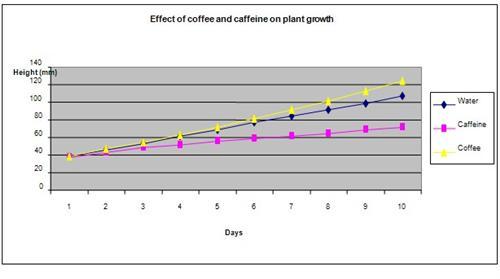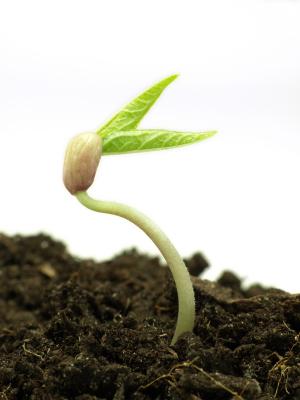| Complexity level: | 5 |
| Project cost ($): | 40 |
| Time required: | 5 days for preparation, 10 days for experiment |
| Material availability: | Easily found |
| Safety concerns: |
Hypothesis
The mung beans watered using the coffee mixture will grow the fastest.
Overview
Caffeine and plant growth
The effect of adding caffeine to the soil and its effect on plant growth is a subject that has been studied for quite some time. Some plants seem to benefit and grow faster when caffeine is added to the soil, while others seem to become stunted or grow slower. There are also some plants that are not affected by the presence of caffeine in the soil.
Caffeine can be introduced to the soil by sprinkling grounded coffee over the soil, adding leftover coffee to the pot or watering with a caffeine solution made by dissolving a caffeine tablet in water. The grounded coffee is actually organic matter and will help in adding nutrients to the soil. It will also attract worms that feed on the grounded coffee and at the same time help to aerate the soil.
Many gardens are known to add grounded coffee to the soil in order to accelerate plant growth. However, it is not clear whether the improved growth is due to the caffeine or the presence of potassium and phosphorous in coffee. It is also possible that caffeine retards plant growth but the presence of potassium and phosphorous in coffee reverses this effect.
Scientific Terms
Materials
The materials required for this science fair project:
- 1 packet of mung beans
- 3 gardening pots
- Enough soil to fill the 3 pots
- Gardening utensils
- Tap water
- Caffeine tablets
- Coffee powder
- 2 beakers
- 1 measuring cylinder
- 1 digital weighing scale
- 1 black marker
Procedure
Procedure:
1. For this science fair project, the independent variable is the solution used to water the plants – water, caffeine solution and a coffee mixture. The dependent variable is the growth of the mung bean plants. This is determined by measuring the height of the plants every day using a ruler. The constants (control variables) are the size of the pot, the concentration of caffeine and coffee, the amount of sunlight, the temperature of the environment (which will remain at room temperature) and the amount of water added daily.
2. Fill the 3 pots with equal amounts of soil. Plant ten mung beans in each pot and allow them to germinate. Additional seeds can be placed in the pots in case some of the seeds do not germinate; the additional plants can be removed later.
3. For the first 5 days, water the 3 pots with tap water only. Allow the seeds to germinate for the first 5 days.
4. After 5 days, measure the height of the 10 plants in each pot. Add up the individual heights and divide by 10 to obtain the average height. Record the average heights in a table, as shown below.
5. Prepare the caffeine solution by dissolving 10g of caffeine tablets in 100ml of water in a beaker. Label the beaker ‘caffeine’. Similarly, add 10g of coffee to 100ml of water in another beaker and label it ‘coffee’.
6. Label the 3 pots ‘water’, ‘caffeine’ or ‘coffee’. Over the next 10 days, water the pots once a day with 100ml water, caffeine solution or coffee mixture, according to the labels on the pots.
7. Measure and calculate the average height of the mung bean plants every day for the next 10 days. Record all calculations in a table, as shown below.

Results
The results show that the mung bean plants grew faster when they were watered using the coffee mixture, but the growth was slower when the plants were watered using the caffeine solution.
| Solution | Height of mung bean plants (mm) | |||||||||
| 1 | 2 | 3 | 4 | 5 | 6 | 7 | 8 | 9 | 10 | |
| Water | 38 | 46 | 53 | 61 | 68 | 77 | 85 | 92 | 99 | 107 |
| Caffeine | 37 | 43 | 48 | 52 | 56 | 59 | 62 | 65 | 68 | 71 |
| Coffee | 39 | 47 | 55 | 63 | 72 | 81 | 92 | 102 | 113 | 125 |
The above results were then plotted onto a graph, as shown below.

Conclusion
The hypothesis that mung beans watered using a coffee mixture will grow the fastest has been proven to be true.
The effect of caffeine on plant growth is still a subject under study. Using grounded coffee in garden lawns is a common practice to make plants grow faster. However, coffee also contains other ingredients like potassium and phosphorous, which are known to enhance plant growth. Experiments on plant growth using only caffeine have resulted in the plant leaves becoming wrinkled, turning brownish and exhibiting retarded growth.
Also consider
Try to repeat the science fair project by using different types of seeds like corn or soy beans.
The experiment can also be repeated using pop soda or tea leaves.
References
http://www.ehow.com/about_5474420_effects-caffeine-plants.html
http://www.mycaffeineaddiction.com/the-effect-of-caffeine-on-plant-growth/

